Ask a question from expert
Dissertation Acknowledgement Example
40 Pages14493 Words269 Views
Added on 2019-12-18
Dissertation Acknowledgement Example
Added on 2019-12-18
BookmarkShareRelated Documents
Dissertation1

ACKNOWLEDGEMENTI am thankful to all those individuals who have provided guidance and assistance as well to accomplish the dissertation. Firstly, I owe my thanks to mentor who gave me chance to undertake this dissertation and motivate me to do it in ethical manner. Furthermore, I am thankful to my team members, family and friends who helped me in all possible settlements. This leads successful finishing point of dissertation and achievement of meaningful results. 2
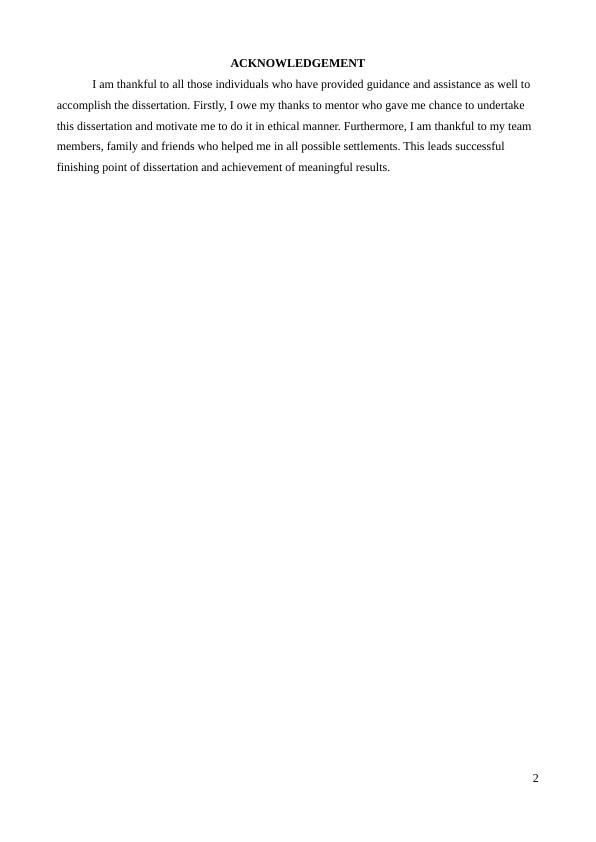
AbstractIn the present times of endless stress and excessive workloads, human has found less timefor self relaxation and pampering which are the basis needs of health and well-being. By combiningthe health benefits of thermal and hydrotherapy that was used in ancient Rome and eastern culturehealth body massage therapy, a new concept related to SPA has invented. Therefore, the presentresearch has been conducted to critically analyze the impact of aesthetics on individual choices forSpa: Studies on Peter Zumthor in Switzerland, Aqua sulis Rome Bath in Britain and Soneva Kiri inThailand. In the report, it has been founded that higher number of people preferred destination andhealth spa to feel relaxed, stress free and energetic. Moreover, through the survey it has beenanalyzed that scent and sound gains high preference among clients that encourage them whether tovisit a particular spa or not. Apart from this, people just prefer to get best quality and elegant beautytreatment and massage therapies for the better stress management and enhance beauty. 3
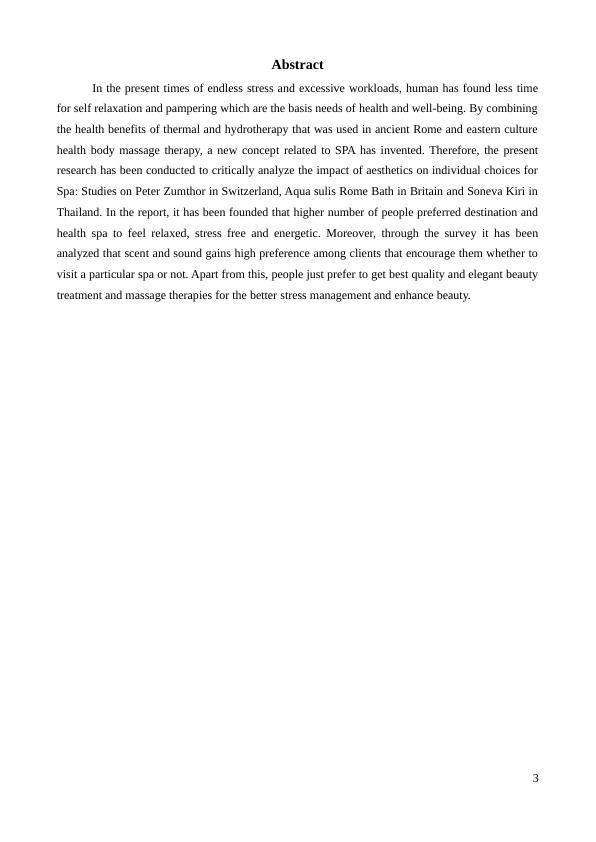
TABLE OF CONTENTSCHAPTER 1: INTRODUCTION.........................................................................................................71.1. Background of the research.......................................................................................................71.2 Small history of spa....................................................................................................................71.3 Problem statement......................................................................................................................81.4 Aim and objectives.....................................................................................................................91.5 Research questions......................................................................................................................91.6 Dissertation structure................................................................................................................10CHAPTER 2: LITERATURE REVIEW............................................................................................122.1 Introduction..............................................................................................................................122.2 History of the spa......................................................................................................................122.3 Different types of spa and their features...................................................................................152.4 Factors associated with sensory designs and architecture of spa.............................................162.5 The aesthetics of spa affect an individual choice.....................................................................172.6 Conclusion................................................................................................................................18CHAPTER 3: RESEARCH METHODOLOGY................................................................................203.1 Introduction..............................................................................................................................203.2 Research type............................................................................................................................203.3 Research approach....................................................................................................................203.4 Research philosophy.................................................................................................................213.5 Research design........................................................................................................................213.6 Data collection..........................................................................................................................213.7 Sampling...................................................................................................................................223.8 Data analysis.............................................................................................................................223.9 Ethical consideration................................................................................................................233.10 Reliability and validity...........................................................................................................243.11 Research limitations................................................................................................................24CHAPTER 4: DATA ANALYSIS AND DISCUSSIOn.....................................................................25CHAPTER 5: CONCLUSION AND RECOMMNEDATION...........................................................375.1 Conclusion................................................................................................................................375.2 Conclusion of data analysis......................................................................................................37REFERENCES...................................................................................................................................39APPENDIX........................................................................................................................................424
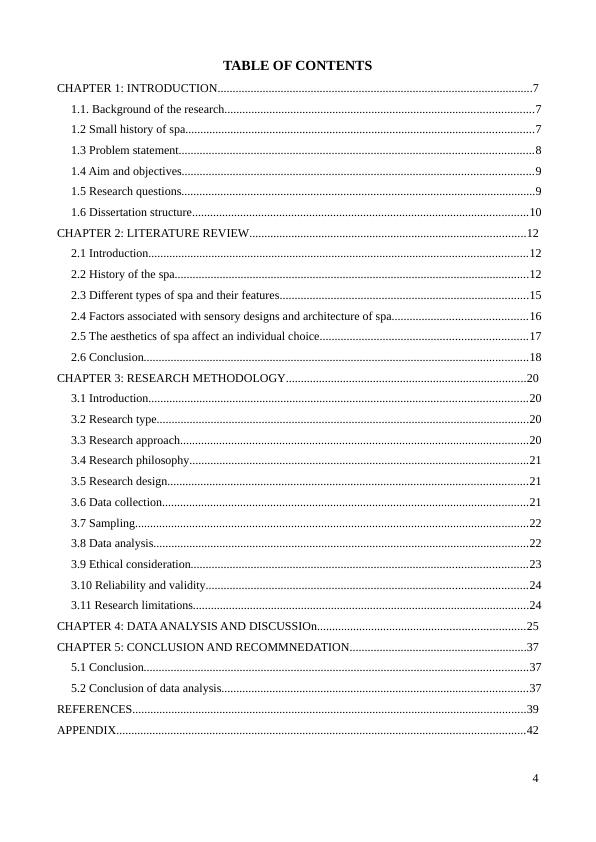
CHAPTER 1: INTRODUCTION 1.1. Background of the researchThe word spa derives from the Walloon word “espa” that means fountain. May be it isrelated to health, relaxation, wellness or anti-aging, these all can be easily attain from spa therapy.In the present time, the increase usage of it is becomes a culture trend (Frost and Laing, 2016).Mainly it is a social bathing in healing waters which is an old and ancient practice that done inGreek and Roman times. As per the report of World Health Organization, health is a state ofcombination of various things such as physical, social wellbeing and mental with the less presenceof infirmity or disease. In the present time, modern day spas have been adopted spa techniques andmethods as a treatments and programs for the people to deliver them well-being (Ez-Zaitouni,Bakker and et.al., 2016). In the age of endless stress and high daily workloads, human has found less time for selfrelaxation and pampering which are the basis needs of health and well-being. By combining thehealth benefits of thermal and hydrotherapy that was used in ancient Rome and eastern culturehealth body massage therapy, a new concept related to SPA has invented (Zlatkovic-Svenda andet.al., 2016). It is playing an important role in the direction of mental and physical remedial in manyof the metropolis geographical areas. People consume spa services because of several reasons. Oneof the common reasons behind using spa therapies are to become de-stress after a long hardworking. A day of hard work combines mental and physical stress that increases the need to takesome relaxation (Urada, Halterman and et.al., 2016). From the research, there are various explanations of the origin of spa in the world has found.Roman Empire time was responsible for the development of the following concept. This methodwas used to recover soldiers from their ailments and wounds during the battles. They inventedthermal water that could able to give relief to aches. For this, some baths at the springs areas weredeveloped that was known with the name of “aquae’ (Ciprian, Nigro and et.al., 2013). In these, thehot water treatments were undertaken to the people. With the passing of time, the culture of spa hasstarted to spread in entire Europe and it has developed the various new spa giving methods. 1.2 Small history of spaThe first period: Classical ageWith the recognition of word Spa and its related water treatments, two ancient culturesbecome easily remember. The first period of spa history was actually started in 500 BC where theancient Greeks were usually take social baths and hot air baths. After 475 years, Emperor Agrippawho was the first Roman was constructed thermae (Brief history of spa (including Roman times),5
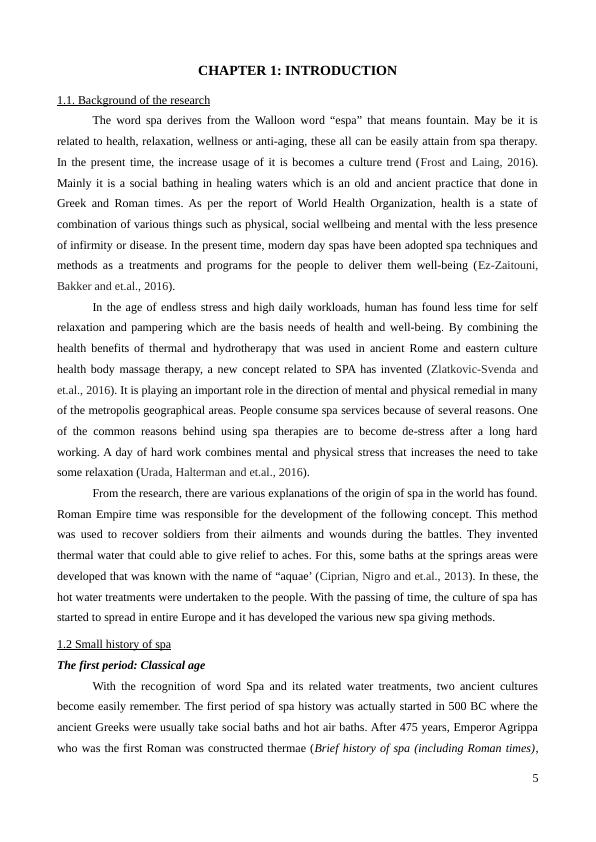
2017). With the time passing of time, there were remarkable development in this area was recorded.Along with this, such kinds of spas were built in entire Roman Empire. Apart from healing servicesand different types of baths, complexes were developed in the form of sport centres and restaurants.In these, after completing exercise in fitness area, it was the ritual where persons could pass throughwarmer rooms where the body was bathed and massaged with oils. After completion of allprocesses, a refreshing dips in the "frigidarium was given to them and sent them specially appointedrooms for relaxations (The History of Spas Timeline: Evolution of the Journey so far...., 2017). Second period: spa culture going around the worldApart from the Roman spa traditions such as combination of cold and hot baths, sportactivities with relaxation and massages, other nations culture in all over the world were formed theirown spa traditions (Annegret and Thomas, 2013). In Japan, after 734 A.D. spa concept has beenvery popular after the construction of first "onsen" i.e. hot spring area near Izumo. After somecenturies later, Japanese was constructed the first "ryokan" (inns) in which people could easily findaccommodation, good food, gardens, indoor and outdoor bath facilities. 300 years later, in Finland,combinative ceremonies such as sweating in the sauna and plummeting in icy lakes with thecomplement of enough beer and vodka was come under the tradition of spa. In 16th century, theBaths of Roxelana was developed where different arrangements related to massive towering, steamrooms, personal and private washing quarters etc were undertaken (Guidelli, Tenti, De Nobili andFioravanti, 2012). Third period: spa traditions in EuropeThe main feature of a spa is its location which has located at natural hot springs. By takinginto the consideration of Renaissance era, there were various resorts developed and they werebecome popular for bathing and healing facilities. In this context, a first scientific book waspublished that was based on the Czech Karlovy Vary health treatments. It was contained therecommendations regarding the application of tonics and thermal baths for relaxations. In additionto this, 1890s, holistic herbal and water therapy innovation in spa was take place (Karagülle andKaragülle, 2015). At the same time, in Europe, the tradition of taking spa in public bath wasbecome downside because of the spread of diseases such as plague etc. 1.3 Problem statementIn the present time, wellness is considering as a highest priority by the people. The reason ofthis is the life style of the people has become highly complex. It has significantly increased with thechange in working culture aspects. From the previous studies, it has found that spa is one of theindustries that create innovative and new sensory experiences and treatments to the customers.6
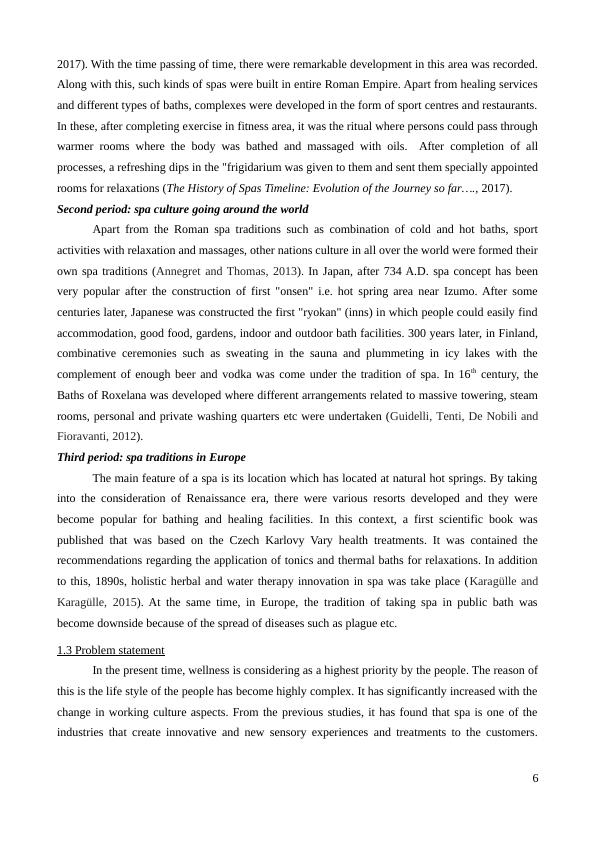
Along with this, to re-position of brand and extending connections with the consumers and newconcepts of spa therapies have been developed to established the connections with the end users.Along with this, from previous conducted researches, it has been determined that spa makers aregrowing at significant level. It is now considering as a health and wellness marker which will growin upcoming future (Leland, 2015). In this respect, it has analyzed by the researchers that people have faced a high level ofstress at the workplace which is affecting their health and well-being at mental and physical terms.To get the relaxation and attain a good health, humans are attracting towards spa services. Byconsidering the following reasons, many of the spa organizations have started to offer various spaservices to the customers that have helped in giving relaxation to them (Johnson, 2012). Increasestress and pressure on a person affects the health of him and it is the issue that needed to be dealwith this. In this context, it becomes important for spa organizations to look towards those factorsand buying behaviour that can easily catch the attention of end users towards avail spa services. Inaddition to this, previous investigations have explained that due to increase disposable income ofthe people, they have able to use spa services which was previously only access by premiumsegment groups. Along with this, these services are now offering to all kinds of age groups. Itbrings the changes in attitude of individuals towards physical fitness to attain general wellbeing(UK spa industry is booming, 2012). 1.4 Aim and objectivesAim To critically analyze the impact of aesthetics on individual choices for Spa: Studies on PeterZumthor in Switzerland, Aqua sulis Rome Bath in Britain and Soneva Kiri in Thailand.ObjectivesTo investigate about historical evolution of spa. To understand different types of spas and their features. To discuss about the factors associated with sensory designs and architecture of spaTo analyze how can the aesthetics of spa affect an individual choice 1.5 Research questions1.Explain the historical evolution of spa. 2.What are the different types of spa and their features?3.Which kinds of factors associated with sensory designs and architecture of spa?4.Explain how can the aesthetics of spa affect an individual choice?7

1.6 Dissertation structureThe present dissertation is base on analyze the impact of aesthetics on individual choices forSpa. In this context, a structure of thesis have prepared that will be followed at the time of carryingof the investigation. It will provide a brief explanation of all chapters by outline main activities.Structure of various chapters for current research is as follows:Chapter 1: Introduction- This chapter will provide the information of various reasons by whichentire research will be carried out. It will explain a brief history of spa evolution. Aim, objectivesand research questions related to the investigation will also stated in chapter 1. After this, at the endof introduction chapter, different research methodologies and other frameworks will discuss. Chapter 2: Literature review- The following chapter will provide insight for conducting theresearch in an effective way. For this, different published researches on selected topic will take intothe consideration. Gather information will help in address the research questions and objectives inan appropriate manner. Chapter 3: Research design and methodology: In this chapter, different research methods will useto support the aim and objectives of the investigation. It will provide a complete guidance toresearcher to solve the research questions. The methods that will use in the research are researchtechniques, data collections, research design, ethical consideration etc. Chapter 4: Result, analysis and discussion – To analyze the selected case studies, secondary datawill take into the consideration. With the help of qualitative technique, collected data will beevaluated and discussion will be made. Chapter 5: Conclusion and recommendations – This chapter will help in draw a meaningfulconclusion on the basis of gather information to the given topic. It will assist the researcher toexplain how the aesthetics of spa can affect an individual choice8
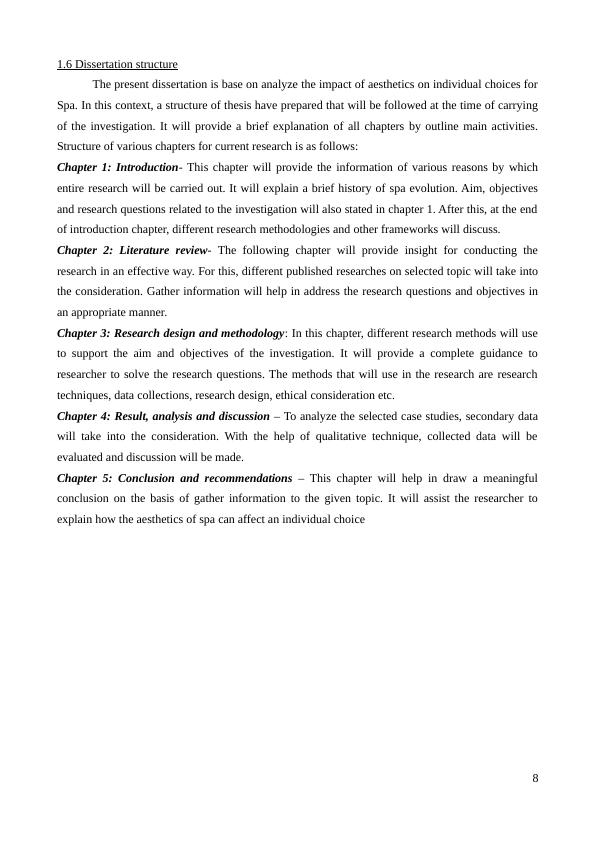
End of preview
Want to access all the pages? Upload your documents or become a member.
Related Documents
Perceptions of Services Users Regarding Health Benefits from Massage Treatments Acknowledgementlg...
|40
|13064
|293
Impact of Social Media Marketing on Customer Satisfaction in UK Retail Sector: A Study on Morrison Plclg...
|47
|13638
|438
Dissertation Assignment 2022lg...
|45
|13164
|39
Impact of Non-Financial Rewards on Employee Motivationlg...
|53
|15813
|40
Analyzing Key Internal Cultural Factors Impacting Project Team’s Performancelg...
|81
|17080
|1
Effectiveness of Pay, Pension and Rewards System in Improving Employee Satisfaction in UK Healthcare Industrylg...
|49
|20340
|319